Chicago Cubs: Is it too early to worry about the 2020 bullpen?

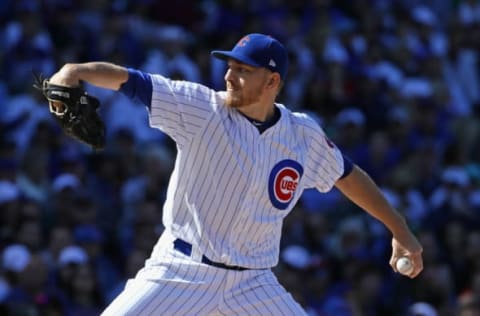
We haven’t yet opened the 2019 campaign, but I’m already worrying about the 2020 Chicago Cubs bullpen and the lack of solid options under team control.
Remember how concerned we were for years prior to three-fifths of the Chicago Cubs starting rotation (Jake Arrieta, John Lackey and Jason Hammel) hitting free agency after the 2017 season? The bullpen is due to have even more potential turnover heading into next season.
At the conclusion of the 2019 campaign, Pedro Strop, Steve Cishek, Brian Duensing, Brandon Kintzler and Xavier Cedeno will all be free agents. Brandon Morrow has a team option for 2020 with a $3 million buyout. Brad Brach has a $5 million option for 2020. Tony Barnette has a $3 million team option for 2020 if he makes the team in 2019.
That only leaves Mike Montgomery and Carl Edwards Jr. as pieces of the 2019 bullpen whose contracts assure they will be back in 2020. Montgomery is under team control via arbitration through 2021. The Cubs’ lanky right-hander, is under team control via arbitration through 2022. If Montgomery finally becomes a full-time starter in 2020, he obviously won’t be in the bullpen.
Tyler Chatwood has two years remaining on his contract (2019 and 2020). However, his role on the team and even if he will continue to be a member of the Cubs is perhaps the biggest question surrounding this year’s bullpen.
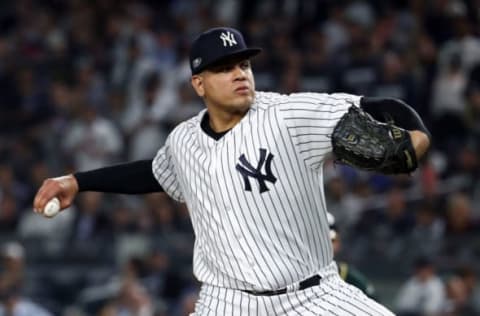
Chicago Cubs: Betances one of the few high-quality options next winter
During the last two offseasons, the free agent market has been ripe with a deep group of relief options.
Last year, the Cubs added Morrow and Cishek among a large group of desirable relief pitchers that included Wade Davis, Greg Holland, Addison Reed, Bryan Shaw and Jake McGee – among others.
This offseason the front office was able to sit back and wait as the free agent market continued to sink lower and lower. This allowed Chicago to add Brad Brach at a bargain salary after Andrew Miller, Zach Britton, Adam Ottavino, Kelvin Herrara, Joe Kelly and David Robertson signed for a lot more.
Next year’s free agent market isn’t anywhere near as deep as the last two. Outside of Dellin Betances, I don’t see a lot of high-quality relief pitchers available. The lower supply could lead to higher salaries for the few quality relief arms which reach free agency. Betances might be able to get several competitive teams bidding against each other for his services.
A lot could change between now and the end of this season. Pitchers who are about to be free agents could have great seasons and become much more desirable. Kensley Jansen could opt out of his contract. The Nationals could decline Sean Doolittle‘s option. Betances could sign an extension or even suffer an injury – we just never know.
Despite those factors, the Cubs’ front office should be prepared for next year’s free agent class to be a smaller part of the answer to building a bullpen than it has been the last two years. Instead, the team should look to re-sign some of their own pitchers, possibly trade for the relievers they need or hopefully finally develop some pitchers from their minor league system.
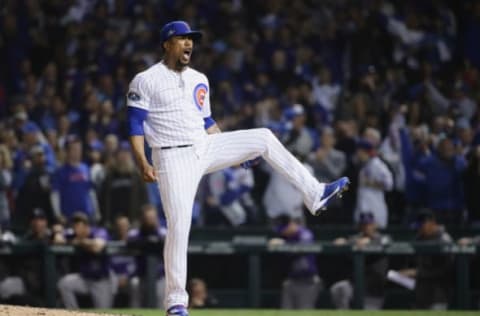
Chicago Cubs: Strop has been an exciting part of the bullpen for a long time
No other pitcher has been more consistent or meant more to the Cubs bullpen during this competitive window than Strop. He’s compiled an earned run average between 2.21 and 2.91 annually since coming to Chicago.
Last year Strop provided his usual excellent work. In 60 games, spanning 59 2/3 innings, he had a 2.26 ERA and a 3.43 FIP. Strop had 57 strikeouts and 21 walks – not to mention a sterling 0.989 WHIP. When Morrow was injured down the stretch, Strop became the fill-in closer. He had a career-high 13 saves in 17 save opportunities.
Unfortunately, Strop’s season essentially ended when he pulled his left hamstring while running out a ground ball. However, Strop came back to pitch one scoreless inning in the NL Wild Card game, despite being in severe pain.
Before the 2018 season, the Dominican-born hurler avoided his final trip through arbitration by signing a one-year contract for $5.85 million with a team option for another year at $6.25 million. The Cubs exercised that team option, which is why Strop is still a member of the Cubs.
But on Opening Day 2020, Strop will be 34 years old. I suspect the front office will take a hard look at re-signing Strop at season’s end. But if he has a bad year or if there are signs age is catching up with him, the bullpen may have to find a way to get batters out without the right-hander for the first time since 2012.

Chicago Cubs: Cishek was the best free agent signing from last year
The Cubs made six significant free agent signings before the 2018 season: Yu Darvish, Chatwood, Morrow, Cishek, Chris Gimenez and they re-signed Duensing. Of those six, only Cishek had a successful season in 2018.
Gimenez was brought in to be a defensive-minded backup catcher. But he didn’t provide enough of an offensive threat (4 hits in 28 at-bats) for even that role. So eventually the Cubs traded Gimenez away to the Twins for Bobby Wilson who was injured and never played a game for Chicago.
Darvish and Morrow showed flashes of what they could be but missed most of the year due to injuries. Most importantly they weren’t available at the end of the season when the Cubs were fighting for their playoff lives.
Cishek was a completely different story. In 2018, the side-arming righty was the workhorse of the bullpen. He pitched in 80 games across 70 1/3 innings (both career-highs). Cishek had excellent results: 2.18 ERA and 3.45 FIP with 78 strikeouts and 28 walks. Joe Maddon used him a lot as the mid-game closer.
Eventually, the team did try to reduce Cishek’s use. He pitched to 60 fewer batters and appeared in 10 fewer games in the second half.
However, that heavy workload appeared to take a toll on him. His ERA was almost a run higher in the second half (2.63 vs. 1.88). And in September and October, that climbed to 4.15.
Last winter, Cishek signed a two-year contract worth $6.5 million annually. So Cishek will be a free agent after this year. If the Cubs do a better job managing Cishek’s usage and if he pitches well again this year, they might try to re-sign him. When the 2020 campaign opens, he will be 33, so he is a year younger than Strop. But because he will be a free agent, there is no guarantee that he will be back – regardless of Chicago’s potential interest.
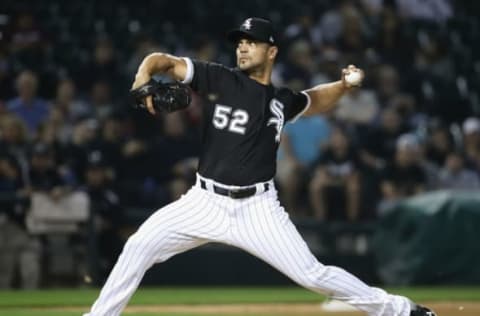
Chicago Cubs: Cedeno might be a big under-the-radar addition
Barnette and Cedeno signed Major League deals with the Cubs shortly before spring training. With the front office obviously trying to save money, these two were part of the front office’s volume approach to trying to piece together the best bullpen with minimal additional salary.
Barnette, 35, signed a one-year, $750,000, Major league contract with a $3 million team option for 2020 and holds a 40-man spot. He played in Japan for a while before coming back to the United States in 2016. Barnette pitched well in 2016 (2.09 ERA in 60 1/3 innings) and last year (2.39 ERA in 26 1/3 innings). In 2017 he did not pitch well (5.49 ERA in 57 1/3 innings). His low inning total last year was due to a pair of injuries: a right-shoulder strain and a strained lat muscle.
Cedeno signed a one-year, $900,000, non-guaranteed, Major League deal. That means that he could be cut in spring training and the Cubs would only have to pay termination pay, which is a fraction of the $900,000. It also means Cedeno is also taking up a spot on the 40-man roster and cannot be optioned to the Minors.
Of these two, Cedeno seemed to be the one more people are excited about. If he looks familiar to you, that might be because he pitched for both the White Sox and Brewers last season. The 32-year-old left-hander had a combined 2.43 ERA and 2.95 FIP in 48 games over 33 1/3 innings, striking out 34 and walking 16.
For his career, Cedeno has been much better against lefties than righties.
- Lefties (91.0 IP): .218/.285/.298
- Righties (84.2 IP): .280/.262/.434
However, last year his splits were nearly equal against both lefties and righties.
- Lefties (15.2 IP): .207/.281/.293
- Righties (17.2 IP): .212/.316/.288
However, Cedeno has an injured wrist on his pitching hand. He isn’t expected to be ready for Opening Day. That also means the Cubs can’t release him for just termination pay. The good news is that once he is healthy, they can stash him in Iowa on a rehab assignment for up to 30 days. If the club is experiencing a roster crunch when he first gets healthy, the front office can use the rehab assignment to delay making a decision for a while.
Cedeno doesn’t have an option in his contract for next year. So even if he pitches well this season, it doesn’t mean he will be around for 2020. If Barnette pitches well, the Cubs may choose to exercise his option. However, if the free agent market continues to collapse as it has during the last two offseasons, $3 million for Barnette might look rather pricey.
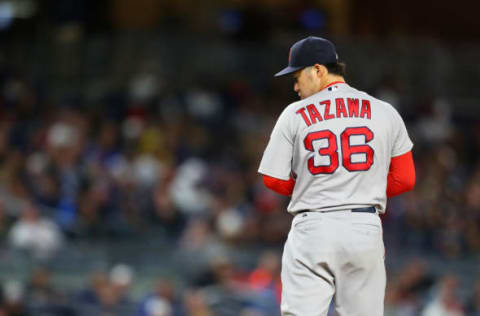
Chicago Cubs: Tazawa trying to make the big league club on a minor league deal
Junichi Tazawa and George Kontos were also part of the front office’s low-cost, high-volume approach this offseason. Unlike Barnette and Cedeno, Tazawa and Kontos signed minor league deals. That means that they are not currently occupying a spot on the 40-man and could conceivably begin the year at Triple-A Iowa.
However, their contracts may have clauses in them that allow them to become free agents if they don’t make the team out of spring training or if they aren’t called up by a specific date. Gimenez’s contract had such a clause last year.
Tazawa was signed by the Red Sox when Theo Epstein and Jed Hoyer were running Boston’s front office. He spent most of his MLB career playing for Boston. But in the last couple of years, he also played for the Marlins and the Dodgers. Kontos also spent most of his career with one team (Giants) and more recently bounced around (Pirates, Indians, Yankees).
Tazawa had a 7.07 ERA and a 6.13 FIP in 28 innings last year. Kontos pitched better. He had a 4.39 ERA and a 5.60 FIP in 26 2/3 innings last year.
I’m not excited about either one of these pitchers. If they pitch for the Cubs this season, it will mean that the guys with the guaranteed contracts either weren’t getting the job done or are injured. It will also mean that the front office has more faith in Tazawa and/or Kontos than they have in younger guys with more upside.

Chicago Cubs: Which version of Duensing will we see this season?
Duensing and Kintzler are two pitchers with more expensive contracts I mentioned earlier. Those deals are going to give these two the inside edge for earning a spot in the bullpen.
However, both players are in the last year of their contracts. So if there are clearly better pitchers in the Cubs systems, the team could release one or both of them. The Cubs don’t want to waste $8.5 million. But if it is the best thing for the team, Duensing’s and Kintzler’s contracts are not enough to guarantee them a spot on the roster.
After a great 2017 season Duensing re-signed with the Cubs for two years at $3.5 million annually. At the time, we were ecstatic about the deal. The veteran literally took less money to stay with the Cubs. He didn’t give up an earned run until May 13, which was his 18th appearance of the season.
But Duensing’s numbers for the season as a whole are a disaster (7.65 ERA, 6.35 FIP). The southpaw took multiple trips to the disabled list and never regained the form he had in 2017 or early in 2018.
I think there is a good chance Duensing can once again be a quality arm. I wouldn’t be surprised to find out that he was pitching through injuries when he was compiling some of those terrible results last season.
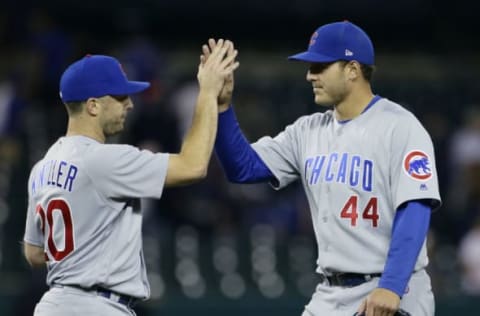
Chicago Cubs: Will Kintzler bounce back in 2019?
Nothing like knowing you’re not really wanted. After the Cubs declined Brandon Kintzler’s $10 million team option, he exercised his $5 million player option for 2019.
Kintzler came to the Cubs from the Washington Nationals in a deadline day deal for minor leaguer Jhon Romero. He had been pitching reasonably well for the Nationals (3.59 ERA). But for the Cubs Kintzler was a disaster (7.00 ERA in 18 innings).
Even the best version of Kintzler doesn’t strikeout many batters. In 2018 he had just 43 in 60 2/3 combined innings. In 2017 he had even fewer strikeouts (39) in more innings (71 1/3 innings).
The best hope for the sinkerballer is he follows the pattern established by Justin Wilson in 2017 and 2018. In 2017, Wilson pitched poorly for the Cubs after a midseason trade (5.09 ERA in 17 2/3 innings with 19 walks). Last year, though, he was one of the best parts of the Cubs bullpen (3.46 ERA in 54 2/3 innings with just 33 walks).
Kintzler may have had some trouble adjusting after being traded to the Cubs. A recent report suggest both the Cubs and Kintzler are trying to find a way to work better together.
I think the Kintzler trade was a mistake. The Nationals offloaded a pitcher on the Cubs who doesn’t strike out batters. At his best, Kintzler depends on not walking anyone while getting weak contact and ground balls – a recipe he failed to follow in Chicago.
Whatever these guys have left, this is their chance to show it. Given their age, there’s little chance they’re back in a Cubs uniform in 2020.
Next. Buyout the injured closer?. dark
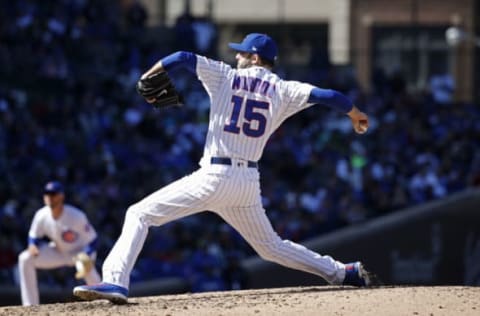
Chicago Cubs Should the Cubs buy out the final year of Morrow’s contract?
Before the 2018 season the Cubs signed Brandon Morrow to a two-year deal. When Morrow was healthy he pitched well for the Cubs. He had a 1.47 ERA and 2.97 FIP in 35 appearances covering 30 2/3 innings. Morrow recorded 50 strikeouts and walked just nine batters. Perhaps most importantly he had 22 saves in 24 opportunities.
Unfortunately, he spent a large portion of last season on the disabled list. In June he was placed on the disabled list with back tightness after comically injuring himself taking off his pants. A month later he was back on the disabled list with a second injury that ended his season.
This November, Morrow had surgery on his right elbow that was described as a clean up procedure. Recovering from this surgery is going to cause him to not be ready for the beginning of the season.
The right-hander’s option for next season is at an increased salary of $12 million. However, his contract also has a $3 million buyout. So after this season the Cubs can either pay Morrow $3 million not to pitch for them or pay him $9 million more to continue to be a part of their bullpen.
As the free agent market continues to collapse, that $9 million may be too steep a price to pay – especially for a guy you can’t count on health-wise.
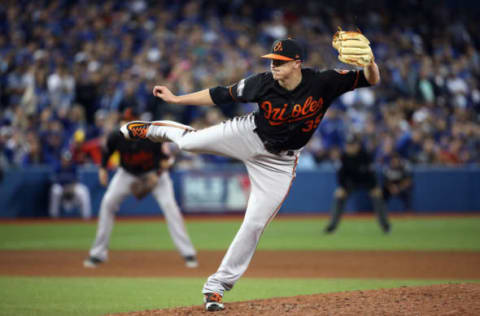
Chicago Cubs: Brach was a great setup man in Baltimore for years
Brad Brach was the biggest addition to the bullpen for 2019. However, the 32-year-old only signed a one-year contract with a $5 million team or $1.35 million player option for 2020.
Brach’s deal took a while to be finalized and was eventually restructured. Turns out he suffered from mononucleosis during the offseason. If he is healthy, Brach will earn the same amount in 2019. But if he misses time, the restructured contract provides the Cubs salary relief.
The right-hander has been a great relief pitcher for a while. He carries a career 3.08 ERA and 3.68 FIP in 424 relief appearances spanning 456 innings. He strikes out 9.5 batters per nine innings while averaging four walks.
Brach was not his usual excellent self early last season with the Orioles. He had a 4.85 ERA and 4.01 FIP in 39 innings. However, after he was traded to the Braves, the hurler rebounded in a big way, compiling a 1.52 ERA and 3.12 FIP with 8.4 strikeouts per nine.
Certainly, the front office hopes that Brach will pitch well this year and that they will want to pick up his option for next season. But the same thing probably could have been said this time last year about Morrow. However, I think the options in Brach’s contract are mostly a result of the depressed free agent market.
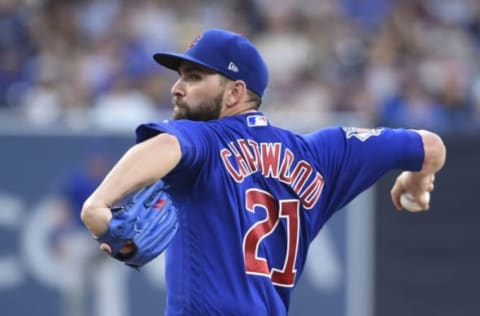
Chicago Cubs: Chatwood has electric stuff, but is that enough?
Tyler Chatwood signed a three-year contract worth $38 million early last offseason. At the time there was a lot to like about the righty. He had significantly better numbers on the road than at his home ballpark of Coors Field.
But his 2018 season was a disaster. He couldn’t find the strike zone enough (8.2 walks per nine innings). When he did manage to throw strikes, however, his stuff was electric. Right-handed batters only had a batting average of .150 against him and slugged just .219. But even with a .150 batting average, right-handed hitters still had a .359 on-base percentage against Chatwood.
Early in spring training, Chatwood seemed to have put his control problems behind him. He had only walked one out of the first 34 batters he faced this spring. But on March 12, he walked three batters in one inning. Of the 47 pitches he threw that day, only 20 of them were strikes.
The Cubs still owe Chatwood $25.5 million over the next two years. This offseason the front office didn’t trust him enough to even allow him to fight for a spot in the starting rotation, exercising Cole Hamels‘ $20 million option.
The Cubs are hoping they don’t waste that $25.5 million. It’s possible the team will be able to trade him away, but to do so they will almost certainly have to pay part of his salary.
Its also possible the right-hander could become an effective reliever for the Cubs. Before he walked three batters in one inning I had more hope for that. Now I’m afraid that he is just going to be the 2019 version of Edwin Jackson.
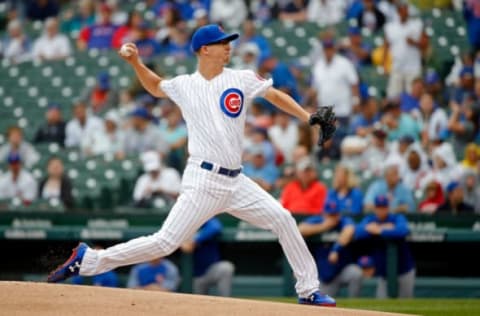
Chicago Cubs: Mills is more than just the answer to a trivia question
The best case scenario for the 2020 bullpen is for prospects to step up and prove they are ready to be part of a big league bullpen.
Last year, Alec Mills started two games for the Cubs. His first start was a sparkling performance in which he only gave up one run in just under six innings. Mills’ second start was not as good, as he allowed four runs in five frames.
Adbert Alzolay was the Cubs’ top pitching prospect last year. He began last season at Triple-A. He seemed destine to get called up to the big leagues at some point, but his season ended early due to a lat injury.
However, nearly everything that was true about Alzolay last year is still true now. He might not be the team’s top pitching prospect any longer. That title arguably goes to Brailyn Marquez, but he is still in the lower levels of the minor league system. Alzolay was on the verge of making his big league debut last season and remains so now.
Alzolay is a starting pitcher. On another team he would be more likely to take a spot in the starting rotation than in the bullpen. If Cole Hamels pitches well this season the Cubs might bring him back in 2020. If Hamels doesn’t come back, Montgomery and Chatwood are under team control in 2020 too. So Alzolay might have to establish himself in the bullpen first and then look to move to the rotation.
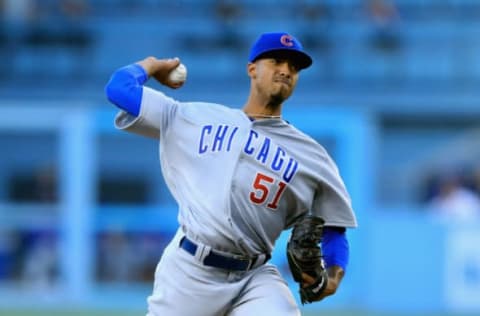
Chicago Cubs: Underwood’s stuff might be better suited for the bullpen
Duane Underwood Jr. made one successful emergency start for the Cubs last season. He only pitched four innings, but he only gave up one run on two hits and three walks. I gave Underwood a break on the low inning total because his first frame began with 41 pitches.
I was most impressed by who he faced and how he was able to work to them. Underwood depends mostly on his four and two-seam fastballs. He occasionally throws change-ups and curveballs to keep hitters honest.
In the minors Underwood has mostly been working as a starter. But his combination of pitches might work better as a reliever. One start in the bigs doesn’t mean he’s ready. But if 2019 is the year Underwood establishes himself as a pitcher who belongs at the Major League level, he might be in the bullpen on Opening Day 2020.
Tseng may be best suited out of the bullpen
Jen-Ho Tseng is a two-time winner of Cubs’ Minor League Pitcher of the Year honors (2014, 2017). He’s made one start for Chicago in each of the past two years. In his 2017 start, he allowed five runs in three innings. Last year, he allowed three runs in two innings.
This is Tseng’s last option year. If he doesn’t soon show the Cubs that he will have value at the Major League level, he might be designated for assignment to make room on the 40-man roster for another prospect. However, before last year Tseng has pitched so well in the minors (3.85 career ERA in the minors) that he might have just had a bad season last year.

Chicago Cubs: Maples has one of the nastiest sliders in the game
Dillon Maples, by all accounts, has one of the nastiest sliders in the game. His problem has been throwing enough strikes to induce swings-and-misses from batters. If the righty doesn’t show the Cubs he has enough control to stay in the big leagues, the team may lose control of Maples to another team. On the other hand, if he figures out his control, he could be a future closer.
Dakota Mekkes, a former tenth-rounder, has a deceptive delivery. Critics have pointed out he shouldn’t be able to get away with relying on his deceptive delivery at the next level. And yet he has rocketed his way all the way up to Triple-A. Mekkes has a career ERA of 1.16 in 147 innings. Last year he had a 1.17 ERA in 57 2/3 innings split between Tennessee and Iowa.
The Cubs were smart to not call Mekkes up last September. This year there is no longer a roster consideration for not adding Mekkes to the 40-man roster. If his’ deceptive delivery will work on hitters as well as it has thus far, he should have the opportunity to show that in 2019.
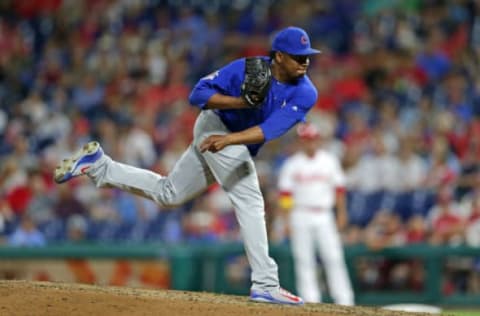
Chicago Cubs: Will Rosario be a long term part of the bullpen?
Randy Rosario was part of the Triple-A pitching depth that did such a great job contributing at the Major league level last year. He had pretty good results (3.66 ERA) despite peripheral statics that suggest he was getting a little bit lucky (4.68 FIP).
Rosario has spent very little time in the upper minors. He split 2016 between High and Double-A. In 2017 he spent time between the same two levels of the Twins’ system. The first time Rosario pitched in triple-A was last year in the Cubs organization when he wasn’t on the major league roster.
As a lefty Rosario will be one of the first guys the Cubs might call up when they need a fresh arm for a few days that Joe Maddon can use in favorable match-ups. If he gets good results again this year, perhaps Rosario will be a full-time member of the bullpen in 2020.
Justin Steele is a left-handed starting pitching prospect who needed Tommy John surgery in 2017. As he made his way back from injury in 2018 threw 46 2/3 innings across three different levels of the minor leagues to a 2.31 ERA. Steele’s season culminated with 10 innings at the Double-A level. He might contribute to big league team in 2019, but 2020 might be just about the right time for Steele to seize an opportunity.
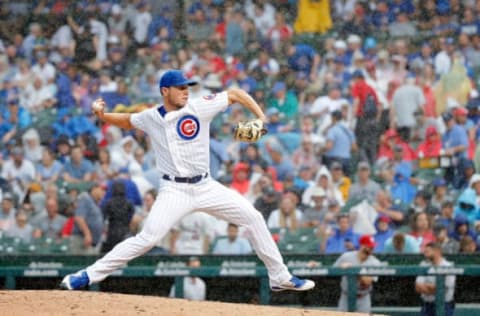
Chicago Cubs: Norwood got a cup of coffee with the Cubs last season
James Norwood pitched in 11 innings in 11 games for the Cubs last season. He struck out 10 and walked five while pitching to a 4.09 ERA, However, his FIP was significantly better at 2.71. This year Norwood will be part of the Cubs’ Triple-A pitching depth.
As a former seventh-round pick, Norwood has defied some of the odds. He’ll have opportunities to pitch for the Cubs in 2019 and if he takes advantage of them, there are some empty spots on the roster in 2020 waiting for him.
Rowan Wick was part of a large group of upper-level pitching depth the Padres had assembled just before this year’s Rule 5 draft. Instead of risking losing some of that depth for nothing the Padres traded Wick to the Cubs for Jason Vosler.
Wick split last year between Double and Triple-A and the big leagues. In the minor leagues, he had a 2.67 ERA in 54 innings. In the Major Leagues, though, he had a terrible 6.48 ERA in 8 1/3 innings.
As someone who only recently converted to being a pitcher Wick is still figuring things out. The jury is still out on this guy.
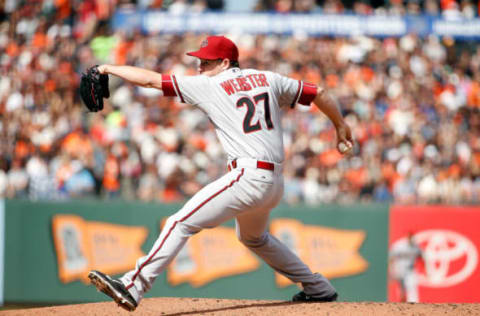
Chicago Cubs: Webster was once a Top 50 prospect in the game
Allen Webster is a former top 50 prospect who is now 29 years old. He pitched in the Major leagues as a starting pitcher from 2012 to 2015.
After working his way back from an injury last year the Cubs converted him to a reliever and rushed him through their minor league system. He got called up for a cup of coffee at the end of last season.
Webster’s change-up set the bar in the Dodgers’ system in 2010 and 2011 – and topped the entire International League in 2014. His slider was ranked the best in the Red Sox system in 2013. So Webster has or at least used to have to excellent stuff.
I’m excited by at the possibility of Webster finding success late in his career by using those two pitches to convert himself into a dominant arm. If he works out this year, the Cubs should find a way to keep him around for 2020.
Kyle Ryan spent a large portion of last season in extended spring training. Prior to last season, he spent two full seasons and parts of two more in the Show with the Tigers. In 86 appearances, he has a career 4.29 FIP.
Ryan has an option left so this year the Cubs will probably bounce him back and forth between Triple-A and the Major leagues this season. If he re-establishes himself at Chicago, he might just end up a bullpen regular in 2020.
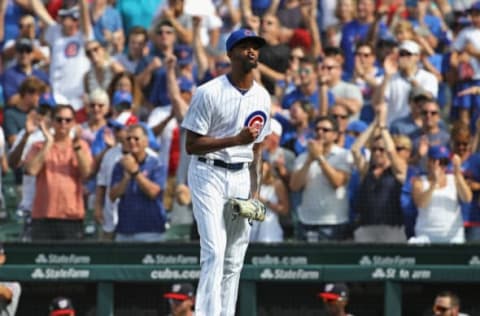
Chicago Cubs: A bold look one year into the future
The 2020 Chicago Cubs bullpen starts and ends with Carl Edwards. He has to conquer the control demons that plagued him down the stretch last season. Alongside Edwards, the Cubs will probably exercise Brach’s option if he pitches well this year.
I doubt the front office will pick up Morrow’s option. Instead, they will probably use the $3 million buyout on his contract. He could get hurt again. Or, if we’re being honest, he could pitch to a level hardly worth $9 million.
More from Cubbies Crib
- Cubs starting pitching has been thriving on the North Side
- Make no mistake: the Cubs are very much about power hitters
- Cubs are giving pitcher Javier Assad a deserved shot
- Cubs: It’s time to start thinking about potential September call-ups
- Cubs: P.J. Higgins deserves to be in the lineup on a daily basis
Montgomery might be in the bullpen, but could begin 2020 in the starting rotation. Even if he begins the year in the bullpen, the last three years have shown us it is only a matter of time before he is needed in the rotation.
The Cubs may try to re-sign Strop and/or Cishek, but that is not a certainty. Both guys may choose to sign with another team even if the Cubs want them. The front office may see some warning signs that one or both of them are not going to not age well. Time will tell.
Chatwood will have one more year on his contract if he is still around. But that is a big if. However, if Chatwood lasts through all of 2019 there is a really good chance that he figured things out and that he will be closer to the pitcher the Cubs thought they were signing rather than the one who lead the Major leagues in walks last season.
Next. Did the Cubs miss out in not adding a big-name reliever?. dark
The rest of the bullpen will have to come from the limited free agent market, costly trades or from the minor league system. The Cubs have already used a lot of trade capital to acquire Aroldis Chapman, Wade Davis and Justin Wilson during this competitive window. When so many high-quality relievers have been available in free agency the last two offseasons, I would hate to see the team trade away prospects for the bullpen again.